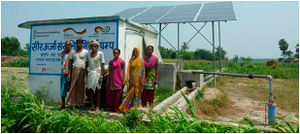Knowledge fuels change - Support energypedia!
For over 10 years, energypedia has been connecting energy experts around the world — helping them share knowledge, learn from each other, and accelerate the global energy transition.
Today, we ask for your support to keep this platform free and accessible to all.
Even a small contribution makes a big difference! If just 10–20% of our 60,000+ monthly visitors donated the equivalent of a cup of coffee — €5 — Energypedia would be fully funded for a whole year.
Is the knowledge you’ve gained through Energypedia this year worth €5 or more?
Your donation keeps the platform running, helps us create new knowledge products, and contributes directly to achieving SDG 7.
Thank you for your support, your donation, big or small, truly matters!
SPIS Toolbox - Credit Policy: Risk Analysis

| ►Back to the Start Page | ►Back to the Module Page | ►Go to the Next Chapter |
3. Credit Policy: Risk Analysis
Every SPIS demands a specific solution with changing cropping pattern and the use of a comparatively newer technology like solar.
Therefore, there are no standard “off the shelf” solutions, and hence a thorough loan analysis is an important step, especially when starting with this loan type.
Typical financial advantages when changing to solar powered irrigation could be:
- Higher profitability when introducing high value crops;
- Lower and more stable energy costs due to change in energy source (no transport costs or fuel/lubricant supply risks);
- Environment friendly technology (avoid water losses, use of water saving technology, prevent diesel pollution, etc.) can give access to subsidized funds or grants.
SPIS, being based on agricultural activities, follow specific liquidity patterns, such as:
- Irregularity, seasonality;
- Farming-household mix;
- Several cash generating activities;
- System risks (climate, weather, pest, disease, prices).
This requires specific agri-lending tools. Thereby the following risks should be considered:
Financial Risks
- High initial capital investment leads to longer repayment periods and higher interest rates for potential borrowers and thus higher credit risks compared to alternative sources. Other specific risks associated with agriculture.
Technology Risks (see the following modules DESIGN, SET UP, MAINTAIN for further details).
- High value cropping and water saving irrigation technology is needed;
- Pumps have to be “oversized” in order to meet peak water demands;
- Management capacities to handle the technology should be available;
- Daily operating hours are limited leading to low asset utilization if not operated properly;
- Suitability of location for SPIS;
- Construction risk;
- Overuse of water threatens long term cultivation as well as the environment.
Framework Risks
- Since water is available at very low cost, long term availability of water and good groundwater management is indispensable; (see SAFEGUARD WATER module)
- People issues leading to delay in disbursal of subsidy, reluctance to lend or adopt solar pump technology etc.;
- Theft or misuse.
Outcome/Product
- Credit risk policy considering the profile of the potential borrowers and adequate portfolio management.
Data Requirements
- Specifics to agri-lending liquidity patterns of borrowers;
- Asset structure of borrowers (potential for collateral), especially land;
- Cropping patterns and profitability of crop types (alternative markets and water availability);
- Organization & management reliability (see MAINTAIN module);
- Technology risks (see DESIGN module);
- Refinancing options for the region.
People/Stakeholders
- Management of financial service providers;
- Public entities promoting or/and subsidizing SPIS initiatives;
- Associations of producers / potential borrowers;
- Market analysts/consultants;
- Technology providers;
- Service providers;
- Research and training institutions (e.g. environmental agency).
Important Issues
- Consider SPIS specific risks with respect to their long term financing requirements, technological implications (cf. DESIGN module), environmental impact (cf. SAFEGUARD WATER module) and framework conditions.
- Assume manifold SPIS settings - there is no “off the shelf” loan analysis.
- Generally, minimizing risks can often lead to high(er) transaction costs (except in a community based system) for all parties involved, compared to conventional pumping systems.
| ►Back to the Start Page | ►Back to the Module Page | ►Go to the Next Chapter |




















